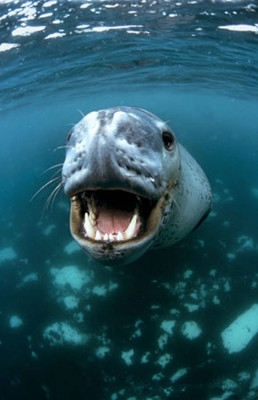科學(xué)技術(shù)
How leopard seals lunch
海豹如何享用它的午餐
Suck, swish, gulp
吸,吮,咽
Eating big and little
大小通吃
JUST about every place on the planet has a predator at the top of the food web.
地球上每個(gè)地方都有一個(gè)處于食物網(wǎng)頂端的捕食者。
The African savannahs have the lion, the jungles of Asia the tiger and the arctic tundra the polar bear.
比如非洲大草原上的獅子,亞洲叢林里的老虎以及北極凍原上的北極熊。
In the Antarctic it is the leopard seals who dominate as voracious hunters of penguins and other seal species.
而南極的霸主則是那些貪婪地捕食著企鵝和其他海豹種群的豹海豹。
 But a new study examining their feeding habits led by David Hocking of Monash University in Australia, has revealed something unusual:
But a new study examining their feeding habits led by David Hocking of Monash University in Australia, has revealed something unusual:
但是一個(gè)驗(yàn)證豹海豹進(jìn)食習(xí)慣的新研究顯示了一些不尋常的東西:
how leopard seals use an efficient filter-feeding system to eat near the bottom of the food chain too.
那就是豹海豹如何利用一個(gè)高效的食物過(guò)濾系統(tǒng)同時(shí)享用靠近食物鏈底端的生物。來(lái)自澳大利亞蒙納什大學(xué)的大衛(wèi)霍金是此項(xiàng)研究的負(fù)責(zé)人。
Researchers have long known that a sizeable portion of the seals’ diet is made up of krill.
研究者們很早就知道在豹海豹的食譜中一大部分是由磷蝦組成。
But exactly how they consume these tiny crustaceans has been a mystery as the seals’ mouths have large sharp teeth that seemed utterly inappropriate for capturing them.
但是由于豹海豹嘴里的尖牙似乎完全不適合捕捉這些磷蝦,從而它們是如何享用這些微小的甲殼類生物便成了一個(gè)迷。
Some researchers have theorised that the seals might suck water into their mouths and swish it past their closed teeth to capture krill.
一些研究者們從理論角度分析豹海豹也許可以通過(guò)先入吸海水再閉緊牙齒將海水吐出的篩選法捕捉磷蝦。
But such behaviour depends upon leopard seals being able to suck up food from water, a specialised feeding behaviour that is rarely seen in top predators.
但是完成這些動(dòng)作需要豹海豹具備從海水中吸吮食物的能力,而這種特定的進(jìn)食行為在位于食物鏈頂端的捕食者身上并不常見。
Keen to explore this, Mr Hocking turned his attention towards Casey and Sabine, two leopard seals at the Taronga Zoo in Sydney.
熱衷于探索這一問(wèn)題的霍金先生將注意力轉(zhuǎn)向了凱西和薩賓這兩只悉尼塔龍加動(dòng)物園的豹海豹身上。
He and his colleagues designed a clear plastic box with thin tubes in which fish could be placed.
他和同事們?cè)O(shè)計(jì)了一種透明的塑料盒子,里面安裝了可以盛放魚的淺的管道。
The seals could not get at them with their teeth, and instead sucked the fish right out of the tubes.
豹海豹無(wú)法用它的牙齒來(lái)取食這些魚,而是從管道中把它們吸出來(lái)。
Moments later, the team saw clouds of murky water and bubbles being expelled from the sides of the seals’ mouths.
過(guò)了一會(huì),研究小組發(fā)現(xiàn)一團(tuán)一團(tuán)的渾濁的水體和泡沫從豹海豹的嘴里噴出。
This, they realised, was a filter-feeding system in action.
研究者們意識(shí)到,這表示一套進(jìn)食過(guò)濾系統(tǒng)正在工作。
In examining the wear on the teeth of skulls from wild leopard seals, Mr Hocking was able to work out which teeth the seals were using to filter out tiny prey.
在檢查野生豹海豹顱骨上牙齒的磨損度時(shí),霍金先生弄明白了豹海豹是用哪些牙齒來(lái)過(guò)濾出微小獵物的。
He found extensive abrasions on canines and incisors, the sharp teeth at the front of their mouths.
他發(fā)現(xiàn)位于口腔前端的那些鋒利的犬齒和門齒上存在大面積磨損的情況。
This, Mr Hocking points out in Polar Biology, indicates that these teeth are used to chomp penguins and other seals.
霍金先生在《極地生物》雜志上指出,這表明豹海豹利用這些牙齒來(lái)撕咬企鵝和其他海豹。
But since there is no such wear on the sharp and delicate postcanines, he believes that although these triangular rear teeth look fierce, when closed they form a sieve that is the perfect size for filtering.
但是,由于在鋒利而精致的犬齒后齒上并沒有發(fā)現(xiàn)磨損的情況,他認(rèn)為盡管這些三角形的后槽牙看上去非常兇狠,但是當(dāng)咬合時(shí),它們可以充當(dāng)一個(gè)對(duì)于過(guò)濾事物來(lái)說(shuō)其尺寸可謂完美的篩子。
Ideal dentistry, if you like, for a mixed diet.
如果你樂(lè)意,這是一套進(jìn)行混合膳食的理想的牙科學(xué)。
 But a new study examining their feeding habits led by David Hocking of Monash University in Australia, has revealed something unusual:
But a new study examining their feeding habits led by David Hocking of Monash University in Australia, has revealed something unusual:
 But a new study examining their feeding habits led by David Hocking of Monash University in Australia, has revealed something unusual:
But a new study examining their feeding habits led by David Hocking of Monash University in Australia, has revealed something unusual: